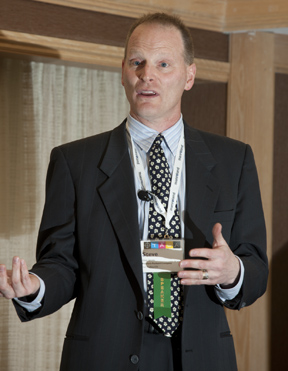The first afternoon sessions of the 2012 TAGA Conference were excellent. Among them was an excellent presentation by Steve Simske, an HP Labs Fellow, who addressed the audience on the topic of security printing, counterfeit prevention, and the effects on the economy of global counterfeiting.
His talk was only partly about the counterfeiting of currency, itself a problem. He spoke about counterfeit products including tennis shoes, handbags, designer dresses, and toner. Apparently Hewlett-Packard suffers from loss of sales to a large number of counterfeit toner cartridges made by companies other than HP. Simske’s work for HP has included markings and on-package security techniques that help HP and law enforcement agencies worldwide to be able to identify authentic merchandise from the pirated variety.
What made Mr. Simske’s presentation so enjoyable was his commentary on economic facts – about two trillion dollars worth of counterfeit products are sold annually into the world economy – and a dollop of HP marketing information that was informative and very obviously prepared by marketers. Simske made reference himself to the way that marketers prepare copy and company information.
Steve Simske of Hewlett-Packard, speaking about security printing, product counterfeiting, and data security during his Sunday’s TAGA conference keynote address.
Mr. Simske’s presentation included a sobering amount of information about the information that companies and agencies gather about us, and also about the private information that we readily give up about ourselves by choosing to use services like store loyalty cards, our responses to online offers, and services like Facebook.
He pointed out that the level of security needed to hack into most accounts is limited to knowledge that can be gleaned in a few minutes by anyone with a rudimentary knowledge of the Internet.
For example, he pointed out that many web sites offer to send you your “lost password” if you simply provide your mother’s maiden name. He mentioned that almost anyone can find that information, then set-up an “anonymized” e-mail address with which to receive the password, and then they will have access to your account.
Though I don’t know how to do the last step in that process, I certainly know how to find your mother’s maiden name – if you have ever used Geni, or Ancestry.com, I can look that information up in a matter of minutes.
We all give up personal information in exchange for “free” services. I have a Facebook account, for example (I haven’t touched it in months). In order to use Facebook, I clicked on a button that said “Agree” and then I moved into my new Facebook space. I published my photo (a delightful image of me wearing a top hat with a pigeon on top). I posted my age, my high school information, my college information, and then immediately began getting ads from classmates.com inviting me to get in touch with old chums from the late ’60s. Did I expose myself to hackers who are looking for information about my family so that they can access my PayPal account? Absolutely! (there is no money in my PayPal account).
Mr. Simske’s presentation was enlightening, a little frightening, and in general it posed a challenge for all of us not to expose ourselves, our companies, our families, or our associates to fraud and fraudulent products. We might enjoy a little tiny bit of privacy in our lives, but judging from our public behavior, it appears not.



